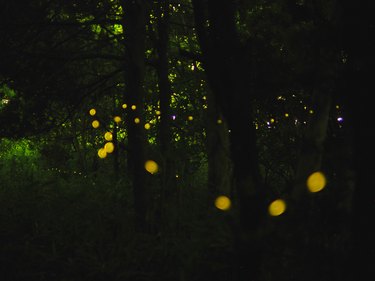
Lightning bugs, also known as fireflies, seem to be an iconic part of childhood. While there are types of fireflies in the lower 48 states, they're much harder to catch at night in the Western and Northern areas. Fireflies are a type of flying North American beetle that use bioluminescence to flash light from their tail as a method to communicate with other fireflies. While it may seem easy to identify fireflies at night, there are several other insects that look remarkably similar to our beloved lightning bugs.
Firefly Biology Basics
Video of the Day
There are many species of fireflies. In general, they have a dark brown or black body with red markings at the head. Their long wings are black and striped brown and cover most of the rest of its body. There are two segments at the tail end of the firefly that produce bioluminescence. This is normally a bright yellow-green color, but some species of fireflies can produce orange or even red light.
Video of the Day
If you've spotted an insect emitting light at night, it isn't necessarily a firefly. Glowing click beetles have two small bioluminescent spots on their head and one in their abdomen, and while they don't flicker on and off, their light may change intensity. Look for multiple sources of light in order to determine whether you're looking at a firefly or a click beetle.
Bugs That Look Like Lightning Bugs
If your bug looks like it has light at its tail but it isn't black like a standard firefly, you might have found a mimic. Some species of longhorn beetles have evolved to have a similar shape and color to fireflies, including two segments on their tail that appear lighter than the rest of their body. The longhorn beetle is browner and won't have the significant red markings on the head that fireflies have.
Your bug may also be a yellow-bordered flower buprestid, a kind of beetle that has evolved to look surprisingly like a firefly in daytime, including the red markings along its tail that mimic the red patches seen on fireflies. Fireflies can be toxic to predators. In this case, the buprestid has evolved to disguise itself as a firefly to dissuade other insects from taking a bite.
Soldier beetles also look a lot like fireflies, with red markings on their head and black wings with stripes. However, they lack the ability to produce bioluminescence from their tail. If your bug doesn't light up but has the coloring of a firefly, examine it closely to see if you have a soldier beetle or a buprestid instead.
Finding Fireflies Outdoors
While many childhood books seem to mention firefly catching, you may have grown up without ever catching sight of a lightning bug at all. This is because fireflies have been quietly disappearing over the last 40 years.
As the use of pesticides spread and human settlements expand into the wilderness, fireflies have been steadily losing ground and have been unable to keep up. In fact, in the Western United States, the remaining species of fireflies produce bioluminescence during the day and stay silent and dark at night. In the Midwest, sightings have decreased, and even national parks in which they could be seen nightly now rarely show a single glow.